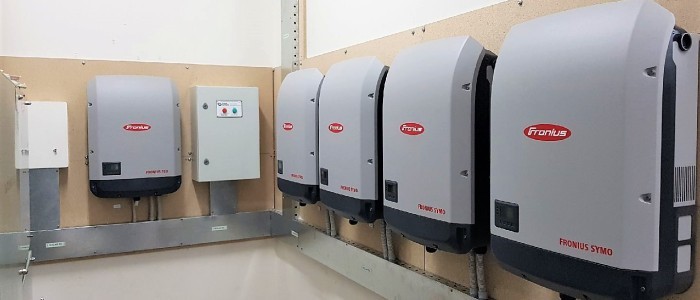When choosing a solar system, one of the key things you have to decide on (or get advice on from an expert) is the type of inverter to install. The inverter is a critical component of the solar system, as it not only converts direct current (DC) energy generated by the solar panels into usable alternating current (AC) energy, but also seamlessly manages the grid connection.
There are three types of inverters that are currently available in the market.
String inverters
String inverters are by far the most commonly used, mostly due to the fact that they are the lower cost type. They are good for installations where individual strings of panels can be installed on a single plane without any shading. However, because all solar panels are connected in a series, a string inverter can only work as well as the weakest link in the chain. This means if a single panel is even partly shaded, every other panel on the same string can only perform as well as that shaded panel, even shade the size of a single hand-print can lead to as much as a 33% loss in performance over not just that single panel, but over a dozen other panels.
Whilst there are certainly higher quality and more reliable string inverters, and there are cheaper and less reliable string inverters, they all suffer from the same weakness, and that is a single shaded or poor performing panel in a string will have an adverse effect on the entire system.
Micro inverters
Micro inverters (such as Enphase) have been on the market for at least 10 years, and are a great solution to help mitigate shading issues, and for a long time were the only real choice of inverter technologies for homes with significant shading problems. They tend to be considerably more expensive than string inverters, because instead of having one large inverter, a smaller/mini inverter is installed behind every solar panel, each not only performing the DC to AC conversion, but each also having to manage grid connection.
The two major advantages of micro inverters is that they allow each individual panel to keep performing at their peak despite some other panels being affected by shade on the roof, and also because there is no single point of failure. If one micro inverter stops working, every other panel can still keep generating power, whereas with a string inverter, if it fails, the whole system will cease to function. Another great feature of micro inverters is that they allow you to monitor the performance of individual panels.
DC optimisers
DC optimisers, also known as power optimisers, are the newest of all three technologies. DC optimisers such as the retro-fitted TIGO TS4-R Optimisers can be selectively deployed to individual panels on a string inverter known to be affected by shade, such as by a chimney etc. This can be a great option where a roof is mostly unaffected by shade, but just one or two panels might be affected. With optimisers installed behind these couple of panels, they will prevent the panels when shaded from affecting the performance of the rest of the string.
SolarEdge is a new inverter technology designed specifically to work with optimisers behind every single panel, and is a fantastic option where shading is more considerable and it makes sense to have a fully optimised system. They are similar to micro inverters in that it allows each panel to operate independently of each other, improves efficiency, and allows each panel to be monitored. This type of inverter is really a cross between string inverters and micro inverters.
String inverters vs micro inverters vs DC optimisers -So, which inverter should you go for?
If you have an unshaded roof that faces just one or two directions, then a conventional string inverter system is a good choice. Remember though, that there are good string inverters and bad string inverters. In our experience, the best string inverter is the Austrian-made Fronius Inverter, as it is the most reliable and efficient.
On the other hand, if you have a roof that is multi-faceted or has significant shading issues where it makes sense to have individual panel optimisation over the whole system, rather than on just a couple of panels where DC optimisers can be selectively deployed, you should opt for either micro inverters or a fully optimised solution like SolarEdge with DC optimisers behind every panel.
There are conditions when micro inverters will work better, and conditions when SolarEdge with optimisers will work better. As a general rule, smaller systems 8 panels or less will work best with micro inverters, and larger systems will work best with SolarEdge. However, there are exceptions. As experts in the technology, we will be able to advise which technology will work best for you.
Beware of installers who take advantage of your lack of understanding and try to sell you a string inverter in conditions where SolarEdge with optimisers or micro inverters would work much better.
Speak to us today to find out which inverter would work best for you. Give us a call at 03 9729 0894 or submit your enquiry today.


